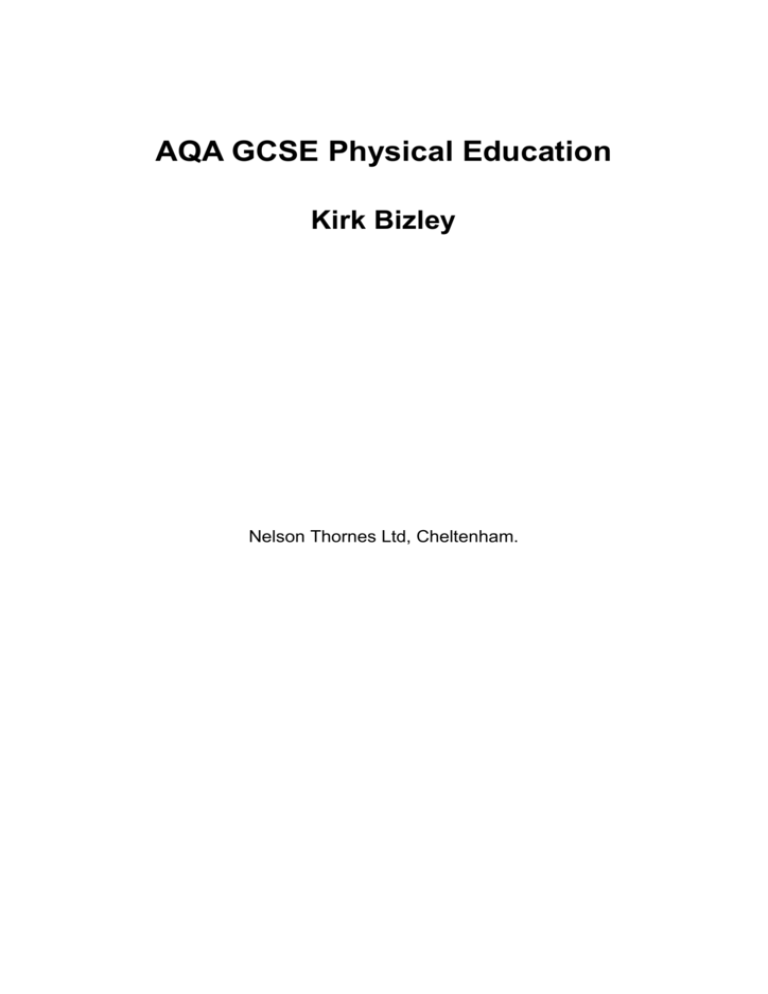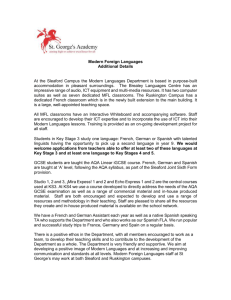
AQA GCSE Physical Education
Kirk Bizley
Nelson Thornes Ltd, Cheltenham.
2
Text © Kirk Bizley 2009
Original illustrations © Nelson Thornes Ltd 2009
The right of Kirk Bizley to be identified as author of this work has been
asserted by him in accordance with the Copyright, Designs and Patents
Act 1988.
All rights reserved. No part of this publication may be reproduced or
transmitted in any form or by any means, electronic or mechanical,
including photocopy, recording or any information storage and retrieval
system, without permission in writing from the publisher or under licence
from the Copyright Licensing Agency Limited, of Saffron House, 6-10
Kirby Street, London, EC1N 8TS.
Any person who commits any unauthorised act in relation to this
publication may be liable to criminal prosecution and civil claims for
damages.
Published in 2009 by Nelson Thornes Ltd, Delta Place, 27 Bath Road,
Cheltenham, GL53 7TH, United Kingdom
10 11 12 13/10 9 8 7 6 5 4
A catalogue record for this book is available from the British Library
ISBN 978 1 4085 0298 3
This adapted version (sections of and/or complete book) mentioned
above has been created under the terms of the CLA Print Disability
Licensing Scheme to be used only by a print-disabled person. Except as
permitted by law, it may not be further copied, nor may it be supplied to
any other person, without permission.
AQA GCSE Physical Education
3
This document is digitally marked with information that can be traced
back to the individual who downloaded it.
AQA GCSE Physical Education
5
Acknowledgements
The author wishes to acknowledge the active support and contributions
of Carol Hackman, Neil Parkinson, Nicola Mellor and colleagues at AQA.
He would also like to thank Downend School for their support and
cooperation in producing many of the photographs in this book.
Dedication
I would like to dedicate this book to my wife Louise, my Mum and my
children, Amber, Joe, Chloe and Jake. I would also like to dedicate it to
Lola, Luca, and all grandchildren to follow.
AQA GCSE Physical Education
Contents
7
[p4]
Contents
Acknowledgements .................................................................................9
Introduction ............................................. Error! Bookmark not defined.
1. The participant as an individual ......................................................... 11
1.1. Age............................................................................................. 13
1.2. Disability ..................................................................................... 18
1.3. Gender ......................................... Error! Bookmark not defined.
1.4. Physique ...................................... Error! Bookmark not defined.
1.5. Environment ................................. Error! Bookmark not defined.
1.6. Risk and challenge ....................... Error! Bookmark not defined.
1.7. Activity levels and needs .............. Error! Bookmark not defined.
1.8. Training ........................................ Error! Bookmark not defined.
1. Chapter summary ............................ Error! Bookmark not defined.
2. Physical and mental demands of performance .. Error! Bookmark not
defined.
2.1. Fatigue and stress ........................ Error! Bookmark not defined.
2.2. Injury ............................................ Error! Bookmark not defined.
2.3. First aid and emergency arrangements ....... Error! Bookmark not
defined.
2.4. The respiratory system: aerobic ... Error! Bookmark not defined.
2.5. The respiratory system: anaerobic Error! Bookmark not defined.
2.6. The circulatory system.................. Error! Bookmark not defined.
AQA GCSE Physical Education
Contents
8
2.7. The cardiovascular system ........... Error! Bookmark not defined.
2. Chapter summary ............................ Error! Bookmark not defined.
AQA GCSE Physical Education
Acknowledgements
9
Acknowledgements
Photo acknowledgements
Alamy: Adrian Sherratt/7.5A; Angela Hampton Picture Library/5.1A;
bobo/12.1F; David Pearson/7.4A; Digital Vision/12.1D; Hugh
Threlfall/12.1A; Image Source Black/12.1B; James Royall/3.1B;
JupiterImages/ BananaStock/12.1C; 12.4A; 12.5A; 12.5B;
JupiterImages/ Pixland/12.2B; JupiterImages/Thinkstock/12.1E; Mikael
Utterström/9.4A; Paul Doyle/5.2B; Profimedia International s.r.o/6.1B;
Roger Bamber/9.3A; Sally and Richard Greenhill/7.2A; 7.5B; Smiley N
Pool/Dallas Morning News/5.9B; Stephen Shepherd/3.2B; The
Photolibrary Wales/8.1A; Corbis: Alan Schein/Zefa / 11.1A; Catherine
Ivill/AMA/2.2B; Christopher Morris/11.3A; Dan Forer/Beateworks/6.5A;
Luo Zianoguang/ch/Xinhua Press/1.3B; Pete Saloutos/zefa/3.1A; Tony
Latham/Loop Images/11.3B; Dartfish: 11.9A; Flora London Marathon:
4.2B; Food Standards Agency/Crown Copyright materials
reproduced with permission of the controller of HMSO: 4.1A;
Fotolia: 1.5B; 1.6A; 5.8A; 5.8B; Getty Images: 1.1B; 1.2A; 1.2B; 1.6B;
2.1A; 2.1B; 2.3B; 5.1B; 5.4B; 6.1A; 8.1B; 10.3A; 11.5A; 11.6B; 12.3A;
12.6A; AFP/4.2A; 5.6B; 5.7B; 6C; 6.2B; 7.3A; 8.2B; 10.3B; 11.2A; 11.2B;
11.8A; Alistair Berg/11.6A; Axiom Photographic Agency/9.3B; Man
Utd/1.8A; Sports Illustrated/2.5A; 9.2A; Tyler Stableford/6.6B;
WireImage/1.4B; Hawk-Eye: 11.9B; iStockphoto: 1.3A; 1.7A; 1.7B;
1.8B; 2.2A; 2.4B; 2.7B; 3.2A; 4C; 4.1B; 5.6A; 5.7A; 5.9A; 6.5B; 6.5C;
6.6A; 9.2B; 12C; 12.1A; 12.1B; 12.2A; 12.2C; 13C; Jim Wileman: P1;
1.1A; 2.3A; 2.6B; 5.2A; 5.4A; 6.3B; 6.4A; 6.4B; 7.1A; 7.1B; 7.2B; 9.1A;
9.1B; 11.7A; 12.1C; Library of Congress: 10.2A; PA Photos: John
Giles/10.2B; John Walton/11.7B; Mike Egerton/11.9C; Nam Y
AQA GCSE Physical Education
Acknowledgements
10
Huh/11.4A; Paulo Amorim/11.5B; Rui Vieira/11.4B; Photofusion
Picture Library: Paul Doyle/9.4B; Rex Features: 6.2A; Lehtikuva
OY/2.5B; Giuliano Bevilacqua/10.1A; NBCUphotobank/11.8B; Tony
Kyriacou/11.1B; Sally and Richard Greenhill Photo Library: 7.3B.
A special thanks to the staff and pupils at Downend School, Bristol for
participating in our photo shoot.
AQA GCSE Physical Education
1
11
[p9]
1
The participant as an individual
In this chapter
1.1. Age
1.2. Disability
1.3. Gender
1.4. Physique
1.5. Environment
1.6. Risk and challenge
1.7. Activity levels and needs
1.8. Training
Aims
Be aware of the effects that ageing may have on the body and how
these might affect the suitability for certain activities.
Be aware of types of disabilities that exist and the ways in which the
disabled can still be active participants.
Be aware of the differences that exist between males and females
and how this can affect participation.
AQA GCSE Physical Education
1
12
Be aware of the links between body type and how this might affect
the suitability for particular activities.
Consider the effects various aspects of the environment may have
upon levels of participation.
Be aware of the factors of risk and challenge and their importance in
physical activity.
Consider the variety of activity levels and needs that exist.
Be aware of the factors that affect the performers' and participants'
ability to train.
This chapter focuses on the different aspects that affect and influence
each individual—some are factors that the individual is able to control
and some are not. Being aware of them is the first step, but being aware
of the effects each can have is the next step.
There are considerable links between all these factors, so it is important
that you consider them in relation to the fact that all people are
individuals with different needs and the majority of factors will also apply
to you as an individual.
Where there is some element of control or choice in the factor (such as
risk and challenge, activity levels and training), being informed may help
you to make some choices, but other factors cannot be altered and you
may need to take these into account in your own individual participation.
AQA GCSE Physical Education
1.1.1
13
[p10]
1.1. Age
D/F/S
Age is one of those factors that we cannot do anything about as it is
beyond our control, but being aware of the effects of ageing is important.
This links to our physiology as well because there are various physical
effects that ageing has on the body that are likely to effect the ways in
which we are able to participate.
Objectives
Consider the effects that ageing has on the body.
Consider further how these effects might affect our suitability for certain
activities.
Look at the necessity for age divisions within sport.
Physical activity and age
Our age directly affects our physical maturity and this in turn affects our
suitability for certain activities for the following reasons:
Flexibility may be quite high in our teens but tends to decrease with
age. This can combine with a tendency to put on weight, which can
also reduce flexibility.
AQA GCSE Physical Education
1.1.1
14
A
Young gymnasts have greater levels of flexibility, which helps them
perform better and score more highly
Strength decreases as we get older, but much younger people will
not achieve maximal strength until they are fully grown, in their late
teens or early twenties. This is why weight training is not
recommended for certain age groups.
Oxygen capacity reduces with age and the heart becomes less
efficient. The arteries gradually lose their elasticity, increasing blood
pressure and reducing blood flow.
Skill levels can improve with age and experience, as well as
improving as we grow and get stronger—a tall basketball player may
find shooting skills easier than a short person.
AQA GCSE Physical Education
1.1.1
15
The older you get, the longer you take to recover from injuries, there
is more chance of suffering from disorders or diseases, and there is
a gradual build up of wear and tear on the body.
Links
Find out more about the physical and mental demands of performance in
Chapter 2 and health, fitness and a healthy active lifestyle in Chapter 5.
[p11]
Being aware of these factors allows an individual to cope with them and
take them into consideration. It is for this reason that nearly all top-level
gymnasts peak in their mid-teens. Few, if any, go on to compete into
their twenties.
Activity
Find out which sports at your school are arranged in age groups. Make
sure you also find out about competitions that the school enters teams
for. Make a list of the different categories that exist across the different
activities.
Age divisions
One of the most basic ways that sport responds to the factor of age is to
introduce age divisions into competitive sport. School sport is always
organised within year groups and it is very unusual for this not to
happen. Major sports organise competitions, championships and
leagues around age but may allow some flexibility by arranging under14, under-16 and under-18 events where it is possible for some players
to play older competitors. The reason for this is that age does not always
AQA GCSE Physical Education
1.1.1
16
affect people in exactly the same way and some young people will
physically mature quicker and be able to cope with older opponents.
However, this is not so common in physical contact sports owing to the
possible dangers of a physical mismatch.
Key terms
Physiology: the functions and processes of the human body.
Flexibility: the range of movement around a joint.
Peak: at your very best—the best prepared period for you to be able to
perform.
AQA GCSE Physical Education
1.1.1
17
B
Laura Robson won the under-18 title at Wimbledon in 2008 when she
was only 14
AQA Examiner's tip
It is important to be aware of the physiological factors linked to age, why
age divisions are always used within sport and examples of sports more
suited to particular age groups.
AQA GCSE Physical Education
1.1.2
18
[p12]
1.2. Disability
D/F/S
Objectives
Consider the types of disability that exist.
Look at the ways in which disabled performers are able to be active
participants.
Consider the measures taken to enable the disabled to participate as
fully as possible.
Disability is an area where the social perception has been raised through
policies of inclusion to ensure that all people are catered for.
Disability can be considered to exist in one of four categories:
Physical
Mental
Permanent
Temporary.
All of the above will affect an individual's ability to take part, but there are
various ways in which these different disabilities can be catered for.
AQA GCSE Physical Education
1.1.2
19
Key terms
Inclusion: a policy that no one should experience barriers to learning as
a result of their disability, heritage, gender, special educational need,
ethnicity, social group, sexual orientation, race or culture.
Equestrian: relating to horseback riding or horseback riders.
Sporting adaptations
All sports can be adapted to cater for either general or specific abilities.
All governing bodies make efforts to make their sport accessible to all,
as the following examples show:
The Paralympics are held every four years immediately after the
Olympic Games. In 2008 there were 20 different events, which
ranged from athletics through to equestrian events and five-a-side
and seven-a-side football. The event gets its name from the Parallel
Olympics, which was first started in 1948 following the Second World
War. Many other competitions are also organised by the IPC
(International Paralympic Committee), which was founded in 1989
and is the international governing body of sports for athletes with a
disability. They were responsible for the first Winter Paralympics in
1994 and encourage all sports authorities to provide competitions for
disabled competitors in that sport.
Links
There are links here to pages 10-11 and 16-17, as well as to the
physical and mental demands of performance in Chapter 2. There will
also be links to science in sport on pages 142-143.
AQA GCSE Physical Education
1.1.2
20
A
The blind football event underway in the 2008 Paralympics in Beijing
Activity
Choose one of the 20 sports featured in the Paralympics and find out all
the disability classifications for one particular activity or event.
[p13]
Adapted sports, such as wheelchair basketball, where the hoop
heights are the same but some of the rules (such as travelling) are
adapted.
Adapted equipment, such as footballs used by the blind and visually
impaired, where there are ball-bearings in small compartments within
the ball so that it is audible and its movement can be tracked. Other
adapted equipment, such as specially designed and adapted
wheelchairs, are now available, not only for basketball and athletics
AQA GCSE Physical Education
1.1.2
21
(here each distance event has different types), but also for fishing,
hockey, tennis, rugby, exercise, yoga and dance.
Disability classifications exist for all activities relating to the particular
physical demands of that sport. For instance, athletics uses a system
of letters (T for track and F for field) and numbers, which identify the
particular disability to make competition fair.
B
Blind runners have able-bodied runners who run next to them to guide
them straight down the track
Facilities
It is a legal requirement that all facilities cater for the disabled in the
following ways:
AQA GCSE Physical Education
1.1.2
22
Access—doors and doorways have to be wide enough to allow
wheelchair access and ramps must be provided.
Parking—disabled bays must be marked and made available.
Provision—lifts must allow access to upper floors, disabled toilets
must be provided, and there should be specific activities, clubs or
classes that are particularly suited to the disabled.
AQA Examiner's tip
It is important to know how the disabled are catered for to enable them
to be active participants. You should also be aware of some examples of
how and when they compete.
AQA GCSE Physical Education
Glossary
23
[p163]
Glossary
Accredited a recognised standard of award leading on to a higher
learning level.
Aerobic exercise exercise carried out using a supply of oxygen.
Aerodynamic shaped to reduce the drag of air passing over it.
Alveoli small air sacs in the lungs where gaseous exchange takes
place.
Ambidextrous the ability to use both hands with equal levels of skill.
Analog a basic single signal, usually transmitted and received by an
aerial.
Antagonist the muscle that relaxes to allow a movement to take place.
Apartheid a policy of separating groups, especially because of race or
colour.
Apprehensive fearful about the future.
Articulation a moveable joint between inflexible parts of the body.
Athlete's foot a fungal infection between the toes.
Basal metabolic rate the minimum rate of energy required to keep all of
the life processes of the body maintained when it is at rest.
Blood pressure the force of the circulating blood on the walls of the
arteries.
AQA GCSE Physical Education
Index
[p166]
Index
A
abdominals 64, 67
abduction 62
abductors 66
accredited 112
activities, low-impact 44, 45
activity groups 148-9, 150-1
activity needs 22-3
adduction 62
adductors 66
aerobic exercise 86, 87
aerobic respiration 34-5
aerodynamic 140
age 10-11, 46
agility 70
alcohol 56
alternate hand throw 71
altitude 19, 87
alveoli 34, 35
amateur 110
ambidextrous 70, 71
anabolic steroids 57
anaerobic respiration 36-7
analog signal 126
AQA GCSE Physical Education
25







